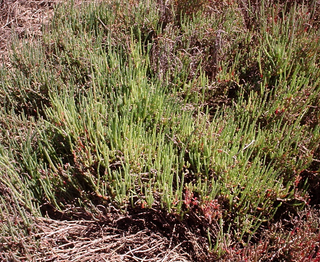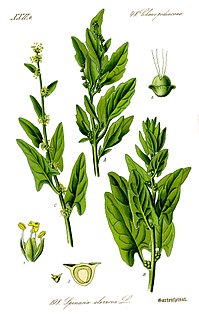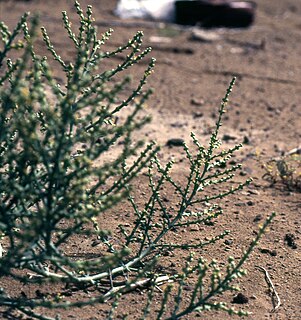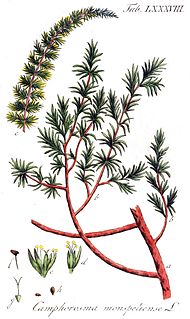
Sarcocornia is a genus of flowering plants in the amaranth family, Amaranthaceae. They are known commonly as samphires, glassworts, or saltworts. The genus has a cosmopolitan distribution, and is most diverse in the Cape Floristic Region of South Africa.

The Salicornioideae are a subfamily of the flowering plant family Amaranthaceae. Important characters are succulent, often articulated stems, strongly reduced leaves, and flowers aggregated in thick, dense spike-shaped thyrses. These halophytic plants are distributed worldwide.

Chenopodium is a genus of numerous species of perennial or annual herbaceous flowering plants known as the goosefoots, which occur almost anywhere in the world. It is placed in the family Amaranthaceae in the APG II system; older classification systems, notably the widely used Cronquist system, separate it and its relatives as Chenopodiaceae, but this leaves the rest of the Amaranthaceae polyphyletic. However, among the Amaranthaceae, the genus Chenopodium is the namesake member of the subfamily Chenopodioideae.

Lechenaultia is a genus of plants in the family Goodeniaceae. Some species of this genus are used as ornamental plants, in particular L. biloba, L. formosa and L. macrantha. Lechenaultia species are diverse in form: they may be woody or herbaceous, upright or prostrate with leaves flat, needle-like or virtually absent in mature plants. The genus differs from other Goodeniaceae in the structure of the stigma and the fertilization mechanism. They are found in Australia and New Guinea.

Tecticornia is a genus of succulent, salt tolerant plants largely endemic to Australia. Taxa in the genus are commonly referred to as samphires. In 2007, the genus Halosarcia, along with three other Australian genera was incorporated into the genus.

Spinacia is a flowering plant genus in the subfamily Chenopodioideae of the family Amaranthaceae. The most common member is spinach.

Adenanthos detmoldii, commonly known as Scott River jugflower or yellow jugflower, is a species of shrub in the family Proteaceae. It is endemic to the south-west of Western Australia.

Seidlitzia stocksii is a shrub species of the family Amaranthaceae.

The Betoideae are a small subfamily of the flowering plant amaranth family, Amaranthaceae sensu lato. Commonly known members include beet, sugar beet, chard, and mangelwurzel, which all are cultivars of Beta vulgaris.

Camphorosmeae is a species-rich tribe of the Amaranthaceae, formerly Chenopodiaceae, with 20 genera and about 179 species. It is classified as a single tribe of subfamily Camphorosmoideae.

Dysphania is a plant genus in the family Amaranthaceae, distributed worldwide from the tropics and subtropics to warm-temperate regions.

Chenopodiastrum is a genus of herbaceous flowering plants in the family Amaranthaceae. The genus was formally described in 2012. The 5 species occur in Eurasia, North Africa, and North America.

Sclerolaena is a genus of annuals or short-lived perennials in the family Chenopodiaceae, which are included in Amaranthaceae according to the APG classification.

Macarthuria is a genus of dicotyledonous plants belonging to the family Macarthuriaceae, and consists of about 9 species which are endemic to Australia.
Eriochiton is a genus of small shrub in the family Chenopodiaceae, which are included in Amaranthaceae according to the APG classification. Species are endemic to Australia.
Gilesia is a monotypic genus of flowering plants belonging to the family Malvaceae. It is also in the Byttnerioideae subfamily and it only contains one species, Gilesia binifloraF.Muell. It is commonly known as the 'western tar-vine'.
Iljinia is a monotypic genus of flowering plants belonging to the family Amaranthaceae. It only contains one species, Iljinia regelii(Bunge) Korovin ex Iljin
Drummondita is a genus of flowering plants belonging to the family Rutaceae.
Menkea is a genus of flowering plants belonging to the family Brassicaceae.
Gibbsia is a genus of flowering plants belonging to the family Urticaceae.














